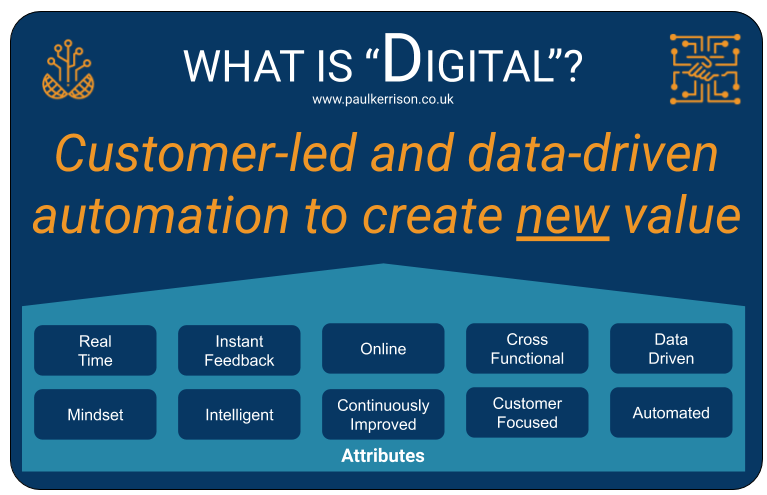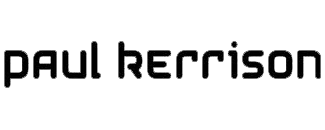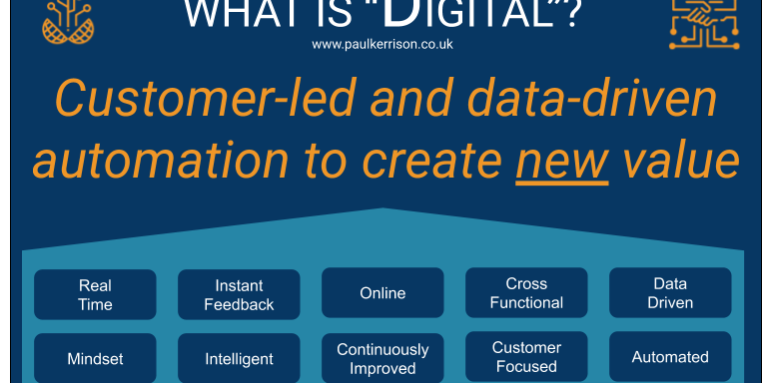Over the last decade or so, there are few words used more regularly and more vaguely to mean more things across the business World as “Digital”.
It means everything and nothing, has justified enormous programs of work and changed the shape and behaviour of organisations of all sizes.
You can add it to pretty much any other word to make it sound exciting, modern and sexy – “not just any thingy, this is a digital thingy”…
But what the devil does it actually mean?
I’ve (superficially) scoured the entire Internet looking for a clear and concise definition and cannot find one. They vary from multi-page theoretical ramblings about customer-centric, capability enhancing, value-add activity to simple but inherently recursive one-liners such as “The use of digital technology to enable a digital business”…which just ties my head up in knots as I work my way unsuccessfully through it….It’s turtles all the way down!
So I gave myself a challenge, could I come up with a simple(ish) definition of what it means. A relatively clear sentence of about 10 words which could be reasonably applied to most uses. This should be easy, I’ve got “Digital” in my job title…surely I know what I do for a living?
Apparently, I do not….
It was not easy at all.
Firstly, you have to get past what I think of as the “pedant hurdle”. We all know what “digital” literally means, the 0s and 1s of Information Technology that have become so popular of late. “Surely we’ve being doing digital for ages” goes the immediate cry, “we don’t have analogue computers fashioned out of elastic bands and tiny cogs, powered by mice in wheels, all IT is digital, therefore the Digital movement is nonsense”
I’m not talking about that, I’m on about what people actually mean when they use it. For the purposes of this post, I’ll refer to the literal meaning as “digital” (lowercase d) and the intentional meaning as “Digital” (uppercase D).
It’s worth saying that Digital is frequently used to mean website or mobile app (especially in more traditional businesses) and I’m also not referencing that (they’re just digital channels). Unless they’re Digital all the way down – through order management, financial reconciliation and fulfillment, it’s just a website – it’s no more Digital than pixelated lipstick on a pig.png….
DEFINITION
Capital D Digital is a tricky beast to nail down…
Having said that and cutting straight to the chase, I’ll get my hammer and at huge risk of personal embarrassment, this is my attempt, drum roll please…hold my beer…
DIGITAL: Customer-led and data-driven automation to create new value
Paul Kerrison 2020
Ta daaaa…wasn’t that exciting!
I fully acknowledge that firstly, that wasn’t exciting and secondly, it’s not going to be perfect. I reserve the right to come back and iterate on it (in true Digital fashion), but I think it’s alright for a starting point. Maybe you will comment with improvements or even a complete replacement – I genuinely hope that happens – the challenge is set…
On the plus side, it’s certainly concise (and doesn’t contain the word digital), I managed to get it into my 10 word limit, but does it make sense, is it clear enough and can it reasonably be applied to most uses?
BREAKING IT DOWN
So how did I get to that?
Trying to munge together all the competing views online wasn’t really cutting it. I was just creating buzzword lists rather than meaningful sentences, so I jotted down all the concepts and then removed everything that wasn’t absolutely crucial (in my opinion). I got it down to four which I believe are key and if any one of these is removed, I think the definition loses something necessary.
- Customer-Led – Customer needs should of course be central to everything a business does – it’s why the business exists. Quite why it’s only relatively recently, that starting with the customer and working back has come into vogue is a mystery to me. Where Digital businesses disrupt and Digital initiatives succeed is when they solve customer problems in a new / streamlined / innovative way. Customers are at the heart of anything Digital. This goes beyond lip service and a superficial app or website, it’s about solving that problem completely….into the nitty gritty legacy stuff and hardwired business processes….’ere be dragons!
- Data-Driven – There’s a notable absence of any specific reference to technology in my definition. This was a hard place to get to as I’m all about the tech! However, I figured that it isn’t the technology per se that makes it Digital, it’s the use of the data to drive the solution that’s important. I expect people will disagree with this and I fully welcome it. What I was trying to do is steer well clear of “Digital Technologies” which seem to centre around Blockchain, IoT, AI etc. I’m pretty sure you can “Go Digital” without those things…but obviously incorporating them would be cool and you’d get extra mega-super-Digital Points! “They” say data is the new oil and whether or not “they’re” right, it’s certainly the case that your propositions should be steered by validated learning and analytics should guide future development if you want to be Digital…
- Automation – This is where it all started for me, automation is the bedrock of Digital. In a Digital business, humans are there to provide the essential human elements and handle everything else by exception. There’s a lot of talk of “smart” things…smart phones, smart tvs, smart toasters and so on, but none of it is really smart, certainly not by human standards. Despite the hype, most of it is actually really dumb, it’s just smarter than a brick smothered in thick creamery butter. This will change with time, but for now, it’s mostly marketing bollocks. However, the ability to automate tasks / processes / roles cutting across business silos to achieve a better customer outcome is very real and probably the most essential element of Digital. Having said that, automation, without the other 3 elements, is just a faster horse and who wants that when you could have a teleporter?
- Create New Value – So here it is…use of an underline that isn’t a hyperlink. What’s that all about and why can’t you click on it? I’ve gone old school, the “new” part is the important bit (that’s how underlines used to work). Replacing a paper form with an online one, processing it automatically and creating a record of some sort is just automation. To be Digital, you need to rethink the entire thing. Instead, create that record automatically by identifying the customer and then inform them about what they want to do. Scary? Yes. Useful? Yes. Creepy? Probably. Disruptive? Definitely. The new normal? Maybe. Experiment and try things out, but fail fast. It’s cliche now, but think big, start small, learn fast! If you’re not creating new value (there’s that underline again) then you’re not going Digital, you’re just automating yesterday…and yesterday gets owned by tomorrow…and I‘ve heard rumours that tomorrow never dies. The word “value” of course means different things to different people, but be clear what it means to you – and measure it…measure it hard.
ATTRIBUTES
We’ve got a 10 word sentence and we’ve got some justification for how it got put together, but there must be more to it than that?
I believe there is. There are a number of attributes that support and enable Digital. They may not be critical enough to make it into the definition in some cases, but they should be the default when thinking in a Digital way. These should only be excluded by exception and after careful consideration about the compromises being made.
- Real-time – Batch is so yesterday. True Digital services need to know what’s happening right now. As soon as someone says, “this gets updated daily” a small piece of everyone’s soul withers away to dust…
- Instant Feedback – Once a customer does something, they should instantly know the outcome and next steps. If they have to wait until tomorrow then a true Digital service will come and eat your lunch…and probably all your other meals too
- Online – Hopefully this goes without saying, but every service your business runs should be available for everyone, everywhere, at any time. Failing that, it’s the Walk of Atonement Time and no one wants to see that (…shame!).
- Cross Functional – Traditional functional silos are nonsensical madness that serve no customer purpose. Digital should cut across them paying the traditional hierarchy no heed, focusing purely on customer need and moving at speed…errrr…until you succeed.
- Data Driven – As discussed above, big data, small data and even the hardly ever mentioned medium data all have their parts to play in informing you and your AIs as to what you should build, how you should build it and its behaviour…It’s the central nervous system of the business. ’nuff said.
- Mindset – There are those that “get it”, those that might and those that never will. Prioritise the ones that do, over and above general “hard” skills and Digital will be easier. The haters gonna hate, hate, hate, hate, hate and you need to shake it off…shake it off.
- Intelligent – Not the people, although that obviously helps. This is more about the systems and processes. Where appropriate, the smarter-than-a-brick smart tech should be making / helping faster decision making.
- Continuously Improved – Updating systems / processes / software on a quarterly release cycle? Bwaaark! You’ll be outmanoeuvred by someone more nimble. Aim to release daily or more often if possible, get speed-to-value sorted and Digital Yoda become you.
- Customer focused – Yes, yes, we all know, customers are handy…Bore on! But really, what’s the customer problem you’re solving? Solve that and you no longer need a salesforce (sorry BusDev!)
- Automated – Everything, where practically possible should be automated. Humans should be adding value using their intrinsically human qualities, bots can handle the mundane. Both will be happier as a result. Well, the bots will be simulated to be happier but who isn’t reassured by a smiley face emoji..?
DIGITAL PRETTIFICATION
Yes, of course prettification is a word….Digital Prettification is even more exciting, modern and sexy…
I’ve combined all of the above into an easy to read (and share!) graphic. It even has the pointless house shape box used by so many consultants which just screams “I’m a serious graphic to be used by serious Enterprises”. As you can probably tell, I have no place at the front end.
For a bit of insight, I also had to stop myself writing “Oh Baby, don’t hurt me” after the title – I’m still fighting that urge now…

You’ll be glad to know I won the fight.
APPLICATION
I accept it’s a bit buzz-wordy, but having wrestled with the words, I’m not sure there’s any way around it.
The next test is whether it fits with the regular uses…
- Digitisation – This is simply creating a digital representation of a physical object e.g. going from cassette tape (arrr memories) to an mp3. This is a prerequisite to being Digital but not the act of Digital itself.
- Digitalisation – Suspiciously similar looking to Digitisation but don’t be fooled, it has an entirely different meaning. This is an effort to make Digital different from digital. I think it’s really just describing all the stuff I’ve listed above – improving business processes / roles by leveraging technologies and data.
- Going Digital – I really hope it works in this context as it is the one I focused on. I think if you’re going Digital, you absolutely should be doing everything in that graphic. If you’re building a website, then if anything, you’re going digital (lowercase d, just to spell it out)
- Digital First – If you say you’re Digital First then everything should be done this way right from the outset. Excepting experimentation and prototyping, it should not be acceptable to relax back into the traditional way of doing things Eg this is a clunkier customer experience but it’s easier to implement
- Digital Transformation – This is typically thought of as much wider than Digitalisation. A reimagining of business activity using Internet-era technologies. I think my definition’s got it covered with the new value part. Remember, I’m only trying to define Digital, don’t get me started on Transformation – that’s a whole post in itself and will definitely involve Optimus Prime.
- Digital Native – This usually means someone who has grown up with the Internet available. It’s a tricky one to link back to Digital but if I stretch it a bit, I think I’d go for someone who has grown to expect the service provided by the definition – they expect to be the customer that does the leading.
- Digital Mindset – If you approach things with a customer mentality, automate everything and use data to guide you in seeking new value I think you can fairly reasonably describe yourself as having a Digital mind. There’s obviously more to it, but that’s a good starter for 10.
- Digital Disruption – Again, I think the new value bit covers this – if you create new value, then you’re likely to disrupt someone…especially if it’s solving a customer problem that wasn’t being addressed properly
- Digital Technologies – Who even knows what this is supposed to mean? It’s usually used to talk about emergent tech but equally could apply to traditional web & mobile apps. I’m calling it out as a bit of a nonsensical term – but feel free to disagree. I’d certainly accept digital technologies (with a small d) to differentiate against a loom, a diesel engine and a pair of scissors.
- Digital Punk – The (only) lyrics in a song by Ferry Corsten that I used to like. If I’m honest, I still do, it makes me want to march. It has no place in this post, there’s no good reason for it to be here. As an aside, I’d also quite like to use it as the name of my consultancy that I don’t have.
So yeah, I guess it’s no surprise that I think my definition and the very subject of this post meets the needs of modern Digital parlance. If it didn’t, I’d probably edit it until it did and then publish it….Maybe that’s exactly what I’ve done…endlessly cycling round and round in an loop of Digital madness…you’ll never know.
What is for sure is that we’re almost at the end now and I don’t have the motivation to go back and rework it all.
FINAL THOUGHTS
You’ve made it this far and I commend you, if it feels like we’ve been on a bit of a journey, then great – it’s sure been one for me. I started with the absolute certainty that I could provide a good definition of something I probably talk about almost daily and it turned out that not only couldn’t I, but I couldn’t find anyone else doing it either.
I might start using it in interviews….”What do you think Digital means?”. It’s a horrible question, there’s no right or wrong answer, but it would certainly test their resolve. I wonder how many Chief Digital Officers / Digital Directors / Heads of Digital Engineering (ahem) out there could give a reasonable answer on the spot…I’m betting not many.
Anyway, this is my attempt at a definition. It’s short, it fits on a graphic and I reckon it’s about as clear as you can get without being vague. One more time for good measure:
DIGITAL: Customer-led and data-driven automation to create new value
Paul Kerrison 2020
Please feel free to provide better alternatives in the comments! My (superficial) trawl of the entire Internet may have left some stones unturned…
For no good reason whatsoever, I’m going to finish on a Digital(ish) limerick
Our systems ran on old machines,
So we planned to move to cloud routines,
Capability chopped,
Incrementally dropped,
And we finally got off green screens!
Paul Kerrison 2020







